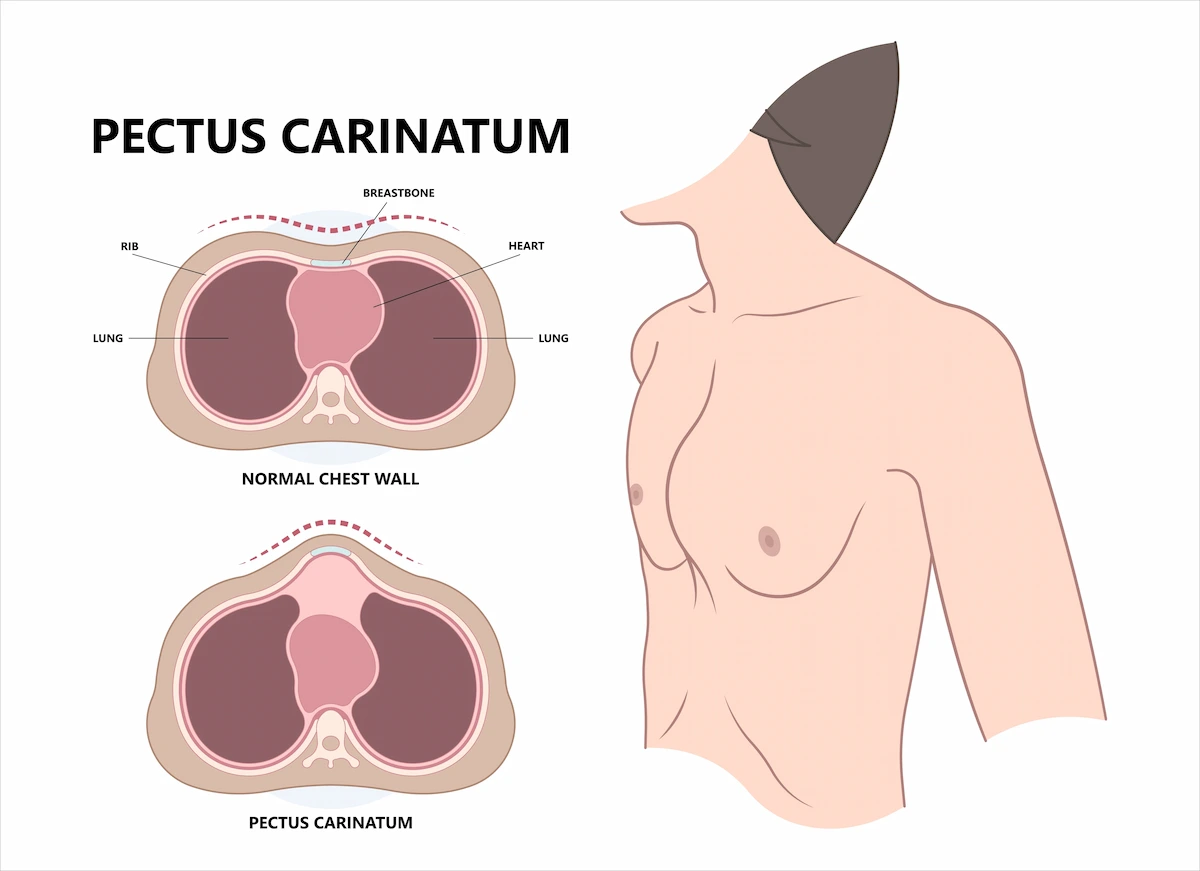Pectus Excavatum Woman: Addressing a Concave Chest

Pectus excavatum, often referred to as a “concave chest,” is a condition where the breastbone sinks into the chest. While it affects both men and women, pectus excavatum woman presents unique considerations. This article aims to provide a comprehensive understanding of this condition, its symptoms, treatments, and how to access expert care in Miami.
What is Pectus Excavatum? A Developmental Condition
What is pectus excavatum? It’s a congenital chest wall deformity, meaning it’s present at birth, although it might become more noticeable during puberty. The exact cause is unknown, but it’s believed to be related to excessive growth of the cartilage connecting the ribs to the breastbone.
Concave Chest: Recognizing the Physical Characteristics
The most noticeable characteristic of pectus excavatum is a concave chest, or a sunken-in appearance of the breastbone. The severity can vary, ranging from mild to severe. In women, this can sometimes lead to concerns about body image and self-esteem.
Pectus Excavatum Symptoms: Beyond Physical Appearance
While the physical appearance is a primary concern, pectus excavatum symptoms can extend beyond aesthetics:
- Shortness of breath: Especially during exercise.
- Chest pain: Particularly after physical activity.
- Heart palpitations: Due to compression of the heart.
- Fatigue: Resulting from reduced lung capacity.
- Frequent respiratory infections: Due to compromised lung function.
- Back pain: From altered posture.

Pectus Excavatum Treatments: Addressing the Condition
Pectus excavatum treatments vary depending on the severity of the condition and the presence of symptoms:
- Conservative Management: For mild cases, physical therapy and exercise can help improve posture and breathing.
- Vacuum Bell Therapy: A non-surgical option that uses suction to lift the breastbone.
- Pectus Excavatum Surgery: For severe cases, surgical procedures like the Nuss procedure or the Ravitch procedure may be necessary.
Pectus Excavatum Surgery: Surgical Interventions
Pectus excavatum surgery is typically recommended when the condition significantly impacts heart and lung function. The Nuss procedure is a minimally invasive technique that uses a metal bar to lift the breastbone. The Ravitch procedure involves removing and reshaping the cartilage.
Primary Doctor in Miami: Your First Point of Contact
If you suspect you have pectus excavatum or are experiencing symptoms, scheduling an appointment with a primary doctor in Miami is crucial. They can:
- Perform an initial assessment.
- Refer you to a specialist, such as a cardiothoracic surgeon.
- Provide ongoing support and care.
- Monitor your overall health.
Considerations for Women:
For women with pectus excavatum, concerns about breast development and body image are common. Open communication with your doctor is essential to address these concerns and develop a comprehensive treatment plan.
Taking Control of Your Health:
- Seek early evaluation.
- Discuss treatment options with your doctor.
- Maintain a healthy lifestyle.
- Address any emotional or psychological concerns.
Early diagnosis and appropriate treatment can significantly improve the quality of life for women with pectus excavatum. If you have any concerns, don’t hesitate to contact our primary doctor in Miami.
Remember, this article is for informational purposes only and does not replace professional medical advice. Always consult with a qualified healthcare provider for diagnosis and treatment.
FAQs: Pectus Excavatum Woman
- Is pectus excavatum more common in men or women?
Pectus excavatum is more common in men than women. However, it does affect women, and they may experience unique concerns related to body image and breast development. - Can pectus excavatum affect my pregnancy or breastfeeding?
In most cases, mild to moderate pectus excavatum does not significantly affect pregnancy or breastfeeding. However, severe cases might cause breathing difficulties during pregnancy. It’s essential to discuss your concerns with your doctor. - Will my pectus excavatum get worse as I age?
The severity of pectus excavatum typically becomes more apparent during puberty. While it may not worsen significantly with age, changes in posture and muscle tone can affect its appearance. - Are there non-surgical options for treating pectus excavatum in women?
Yes, non-surgical options like vacuum bell therapy and physical therapy can be effective for mild to moderate cases. Your doctor can help determine the best approach for your specific situation. - What should I expect from pectus excavatum surgery, and how long is the recovery?
Pectus excavatum surgery, like the Nuss procedure, involves placing a metal bar to reshape the chest wall. Recovery time varies, but it typically involves several weeks of limited activity and pain management. Your surgeon will provide detailed post-operative instructions.
Contact Us
Hiriart & Lopez MD, LLC
9950 SW 107th Ave STE 101,
Miami, FL 33176
305-274-8779
Phone: (305) 274-8779
Fax: (305) 274-0646
OPENING HOURS
Monday 7:30 AM–4:30 PM
Tuesday 7:30 AM–4:30 PM
Wednesday 7:30 AM–4:30 PM
Thursday 7:30 AM–4:30 PM
Friday 7:30–11 AM
Saturday Closed
Sunday Closed
OFFICE LOCATION
Pectus Excavatum Woman: Addressing a Concave Chest

Pectus excavatum, often referred to as a “concave chest,” is a condition where the breastbone sinks into the chest. While it affects both men and women, pectus excavatum woman presents unique considerations. This article aims to provide a comprehensive understanding of this condition, its symptoms, treatments, and how to access expert care in Miami.
What is Pectus Excavatum? A Developmental Condition
What is pectus excavatum? It’s a congenital chest wall deformity, meaning it’s present at birth, although it might become more noticeable during puberty. The exact cause is unknown, but it’s believed to be related to excessive growth of the cartilage connecting the ribs to the breastbone.
Concave Chest: Recognizing the Physical Characteristics
The most noticeable characteristic of pectus excavatum is a concave chest, or a sunken-in appearance of the breastbone. The severity can vary, ranging from mild to severe. In women, this can sometimes lead to concerns about body image and self-esteem.
Pectus Excavatum Symptoms: Beyond Physical Appearance
While the physical appearance is a primary concern, pectus excavatum symptoms can extend beyond aesthetics:
- Shortness of breath: Especially during exercise.
- Chest pain: Particularly after physical activity.
- Heart palpitations: Due to compression of the heart.
- Fatigue: Resulting from reduced lung capacity.
- Frequent respiratory infections: Due to compromised lung function.
- Back pain: From altered posture.

Pectus Excavatum Treatments: Addressing the Condition
Pectus excavatum treatments vary depending on the severity of the condition and the presence of symptoms:
- Conservative Management: For mild cases, physical therapy and exercise can help improve posture and breathing.
- Vacuum Bell Therapy: A non-surgical option that uses suction to lift the breastbone.
- Pectus Excavatum Surgery: For severe cases, surgical procedures like the Nuss procedure or the Ravitch procedure may be necessary.
Pectus Excavatum Surgery: Surgical Interventions
Pectus excavatum surgery is typically recommended when the condition significantly impacts heart and lung function. The Nuss procedure is a minimally invasive technique that uses a metal bar to lift the breastbone. The Ravitch procedure involves removing and reshaping the cartilage.
Primary Doctor in Miami: Your First Point of Contact
If you suspect you have pectus excavatum or are experiencing symptoms, scheduling an appointment with a primary doctor in Miami is crucial. They can:
- Perform an initial assessment.
- Refer you to a specialist, such as a cardiothoracic surgeon.
- Provide ongoing support and care.
- Monitor your overall health.
Considerations for Women:
For women with pectus excavatum, concerns about breast development and body image are common. Open communication with your doctor is essential to address these concerns and develop a comprehensive treatment plan.
Taking Control of Your Health:
- Seek early evaluation.
- Discuss treatment options with your doctor.
- Maintain a healthy lifestyle.
- Address any emotional or psychological concerns.
Early diagnosis and appropriate treatment can significantly improve the quality of life for women with pectus excavatum. If you have any concerns, don’t hesitate to contact our primary doctor in Miami.
Remember, this article is for informational purposes only and does not replace professional medical advice. Always consult with a qualified healthcare provider for diagnosis and treatment.
FAQs: Pectus Excavatum Woman
- Is pectus excavatum more common in men or women?
Pectus excavatum is more common in men than women. However, it does affect women, and they may experience unique concerns related to body image and breast development. - Can pectus excavatum affect my pregnancy or breastfeeding?
In most cases, mild to moderate pectus excavatum does not significantly affect pregnancy or breastfeeding. However, severe cases might cause breathing difficulties during pregnancy. It’s essential to discuss your concerns with your doctor. - Will my pectus excavatum get worse as I age?
The severity of pectus excavatum typically becomes more apparent during puberty. While it may not worsen significantly with age, changes in posture and muscle tone can affect its appearance. - Are there non-surgical options for treating pectus excavatum in women?
Yes, non-surgical options like vacuum bell therapy and physical therapy can be effective for mild to moderate cases. Your doctor can help determine the best approach for your specific situation. - What should I expect from pectus excavatum surgery, and how long is the recovery?
Pectus excavatum surgery, like the Nuss procedure, involves placing a metal bar to reshape the chest wall. Recovery time varies, but it typically involves several weeks of limited activity and pain management. Your surgeon will provide detailed post-operative instructions.
Contact Us
Hiriart & Lopez MD, LLC
9950 SW 107th Ave STE 101,
Miami, FL 33176
305-274-8779
Phone: (305) 274-8779
Fax: (305) 274-0646
OPENING HOURS
Monday 7:30 AM–4:30 PM
Tuesday 7:30 AM–4:30 PM
Wednesday 7:30 AM–4:30 PM
Thursday 7:30 AM–4:30 PM
Friday 7:30–11 AM
Saturday Closed
Sunday Closed

